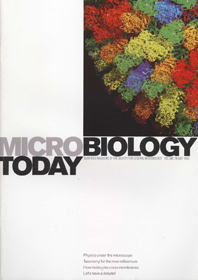Biophysics
01 May 1999 publication
The lead articles of the May 1999 issue of Microbiology Today are on physics under the microscope; taxonomy for the new millennium; and how molecules cross membranes.
Physics under the microscope (p. 50)
Dave Roberts explains how for this issue the Society sought articles that discuss the physics of instruments, what limits their performance and what future developments there might be.
It's all a question of image (p. 51)
Dave Roberts and Gianfranco Novarino discuss imaging in microbiology.
Atomic force microscopy (p. 54)
Alastair Smith explains what atomic force microscopy is and what it is used for.
Cryo-electron microscopy: taking back the knight (p. 55)
Stephen Fuller discusses the merits and the future of cryo-EM.
Crystallography and the atomic anatomy of viruses (p. 59)
David Stuart, Jonathan Grimes, Nick Burroughs and Peter Mertens talk about crystallography.
Nuclear magnetic resistance (NMR): keeping pace with microbiology (p. 62)
Stephen Matthews explains the uses of nuclear magnetic resonance in microbiology.
What a Raman spectrum can tell the microbial ecologist (p. 64)
Nozomi Ytow describes the Raman spectrum and discusses the applications of it.
Bacterial classification and taxonomy: a 'primer' for the new millennium (p. 70)
Howard Gest questions the validity of some of the resultant changes to taxonomy.
Meeting preview: Delivering the goods (p. 74)
A preview of the Main Symposium 'How Do Molecules Cross Microbial Membranes?'
Let's have a debate! (p. 77)
Philip Mortimer raises the subject of debates as a means of scientific communication.
Gradline (p. 89)
The Society hears from Liz Mathew and Susan McGrath, two Society members who took part in the Young Life Scientist of the UK competition.
Going Public (p. 90)
Several important events to foster the public understanding of science, such as SETweek, take place in the spring. The Society is an active participant and our recent activities are described.
Comment (p. 104)
In the Comment section of this issue, we print letters from our readers on their views on the new Microbiology Today.

